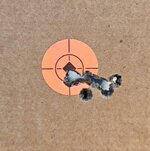pbroski
Lil-Rokslider
That's my understanding, but I'm in a similar place scratching my head about couple loads with SDs less than 10fps and tight 4-5 shot groups except for one wild flier 1-2" off average point of aim. Neck tension/interference fit seems like a likely variable. Tough to pin the fliers on anything.
I know what you mean. I also experience wild shots fairly frequently, but I have a hard time believing neck tension is the culprit. I neck turn the brass, which results in neck thickness variance of .00025" or less, and anneal every loading on an AMP annealer using the same Aztec setting, so the necks should be very consistent. I can't see how 9 shots can cluster, then 1 jump so far out based on neck tension variance. (That is as long as there is no donut present. If there is a donut and the bullet is seated into it, then all bets are off.)
I have a sneaking suspicion the true candidate for the discrepancy is actually the bullets themselves. There may be concentricity issues.
An any case, I'm going to pay closer attention to neck tension variance by utilizing my AMP press to track neck tension to see if there is a direct correlation between it and precision.

